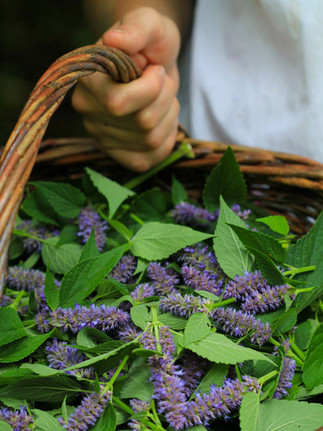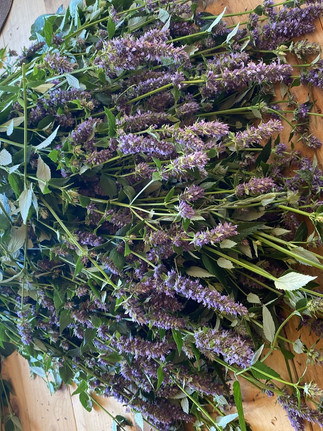Fennel Agastache : a Sweet Delicacy with Digestive Properties
- Herboristerie La Fée des Bois

- May 8, 2024
- 6 min read
Fennel agastache (Agastache foeniculum) is an aromatic perennial belonging to the Lamiaceae family.

A Bit of History
Also known as hyssop anise, hyssop anise, hyssop grande or simply agastache. Its name can sometimes be confusing, as there are over 20 different types of agastache (in this case, foeniculum) and a plant quite different from agastache called hyssop (Hyssopus officinalis), which should not be confused.
Fennel agastache is a herbaceous member of the mint family, native to North America but introduced to Quebec. It was introduced to Europe as an ornamental plant, then as a melliferous plant thanks to its aniseed fragrance, and finally as an ingredient in cooking and herbal medicine.
Etymologically, fennel agastache takes its name from the Greek agathos (good, excellent, admirable) and Foeniculum (fennel). This important plant was widely used by the indigenous peoples of North America, who used it as an infusion to treat fevers, colds, heart problems and colds, and as a poultice for burns.
Today, in addition to its medicinal properties, it will be found as an ornamental plant in gardens, and will also be used in perfumery and the food industry for its characteristic scents of anise, licorice and menthol.
It grows in a variety of habitats, including meadows, woodlands and rocky slopes. Fennel agastache is characterized by a mass of vertical stems, which can reach over 1 metre in height when flowering. The opposite, cordate to lanceolate leaves have a serrated margin reminiscent of a nettle leaf, and measure up to 10 cm long and 5 cm wide. In summer, Agastache produces spikes of tubular, two-lipped, blue/purple flowers.

Cultivation and Harvest
Fennel agastache is a perennial, but can be grown as an annual in colder climates.
It prefers well-drained soil and full sun to part shade.
Moderate watering is advisable and, to encourage new flowering and continued growth during the flowering season, be sure to prune back wilted stems; this will also prevent the plant from self-seeding.
Fennel agastache is resistant to deer and rabbits, and is a major attraction for bees, butterflies and hummingbirds.
Here at La Fée des Bois Apothecary, we've been growing it since the very beginning. A plant of great importance for flavouring and sweetening our herbal tea blends, as well as for its medicinal properties.
It has to be said that it's delicate in zone 3B/4, the farm's climate, so we've lost some of it from time to time, despite the protective straw mulch we cover it with for the winter. We don't take any more chances and start from seed every year. In any case, it's a plant that's much tastier in its first year or two of life.
It's one of Mariane's favorite plants to harvest, even though hundreds of bees gather on it during the harvest, as we pick it at its floral peak.
It's a wonderful plant for children to discover. It's one of the first plants Valentin tasted in the garden, and he's delighted to introduce it to the children who visit the gardens; he calls it "the sweet plant".

Properties
When we think of fennel agastache, we immediately think of the digestive system. A must-have, it brings incredible comfort, not to mention its delicious sweet (sugar-free) taste, which is medicine in itself, especially for diabetics or people who want to eat sweet foods, as it offers a great alternative!
Digestion : like most aromatic herbs in the mint family, fennel agastache has carminative properties, meaning it reduces or prevents excess gas in the intestines. Rich in volatile oils, it acts by gently irritating the gastric mucosa, increasing peristalsis and regulating intestinal contractions. This calms the intestine, relieving cramps, reducing bloating and gas, and facilitating gas expulsion. It helps relax the smooth muscles of the intestines and increases bile production, which helps break down fats and hard-to-digest foods.
It's also a great mother/baby plant, calming baby's colic and increasing the mother's milk production. It can also be given directly to the baby; children usually like the taste. Fennel can be considered for medium- to long-term use for a child who is very colicky.
Fennel agastache is also very rich in antioxidants, making it a general anti-inflammatory and an excellent plant for protecting the body and maintaining good health, including cardiovascular health.
Traditionally, it was used in traditional native medicine to relieve bronchial congestion and coughs, and to treat digestive problems and diarrhea, particularly that caused by bacteria or viruses. Its infusion was used for dry coughs, colds, chills, angina, fever and chest pain. Indeed, its essential oils have an antispasmodic effect on the respiratory system.
Fennel Agastache In the Kitchen
Fennel agastache really shines here! Its flavor is even more wonderful than its appearance. Its sweet black licorice taste is reminiscent of old-fashioned licorice candy - sweet and creamy. The leaves and flowers are highly prized in cooking, and can be used in sweet or savory concoctions. Each of the parts has a different flavor potency, enabling better flavor specification when used in cooking.
Of course, delicious in a wide range of beverages, there's no shortage of refreshing drinks, whether alcoholic or non-alcoholic. Make lemonade by mixing lemon or lime juice with an infusion of fennel agastache that has been chilled in the fridge: in midsummer, it'll be a pure delight for the whole family!
Fresh fennel agastache leaves are delicious in salads, adding a unique, refreshing flavor! As a dip, you can chop them up and mix them with plain Greek yoghurt, a little lemon juice and honey. The result will be the lightest with crudités!
When cooking, feel free to use agastache leaves and flowers as you would other herbs. However, to retain all the benefits of estragol, the molecule that gives it its flavor, be sure to add the leaves at the end of cooking :
In soups, curries, stews, even ratatouille!
In meat or fish dishes.
In pasta sauces.
In omelettes and quiches.
For pastries and desserts, infuse the leaves in milk to flavor creams, custards or ice creams. You can also add dried or fresh fennel agastache flowers to your cookie or cake recipes, or use them as sweet decorations all over the place.
Its taste is quite powerful, so use it sparingly at first. Have fun experimenting and discovering new flavor combinations: the possibilities are endless with this plant!
Contraindications/Precautions/Interactions
This essential oil is not recommended for pregnant women.
Uses and Dosage
Infusion : 1-2 teaspoons of dried leaves, infused for 10 to 15 minutes in a cup of boiling water, 1 to 3 cups a day.
Mother tincture : 1 to 2 ml, 1 to 6 times a day.
Essential oil : a few drops to be diluted in a vegetable oil and applied to the area to be treated.
Cataplasm : crush fresh agastache leaves to make a paste and apply to the area to be treated (burns, insect bites, small wounds). wounds).
Our Herbal Products Using Fennel Agastache
Digestive Bitter Tonic : https://www.herboristerielafeedesbois.com/product-page/tonique-digestif-amer
Our Digestive Bitter Tonic helps stabilize blood sugar levels and will relieve many digestive discomforts such as occasional gas and bloating, heartburn, indigestion and nausea.
Today's diet is generally devoid of the bitter flavors that are important in the production of saliva, gastric juices, enzymes and bile, so Digestive Bitter Tonic is there to fill the gap!
Rich in inulin and prebiotics, it promotes intestinal well-being. In other words, it promotes better waste elimination and nutrient assimilation.
Pachamama Herbal Tea : https://www.herboristerielafeedesbois.com/product-page/tisane-pachamama
Made from agastache, blessed thistle, calendula, nettle and oats, this herbal tea is rich in minerals and trace elements. It's a general tonic that promotes vitality and energy. A perfect springtime beverage with its slightly bitter herbs, to support digestion and give yourself a little spring treatment, without demineralizing.
Ideal for sleep-deprived new mothers recovering from childbirth, but also for breastfeeding mothers, as this complex promotes the production of nourishing milk for baby.
Digestive Herbal Tea : https://www.herboristerielafeedesbois.com/product-page/tisane-digestive
Our Digestive Herbal Tea is delicious after meals for its digestive properties, or simply for pleasure at any time of day. It is pleasantly mentholated, aniseed-flavored and naturally sweetened, with a delicate bitterness.
It promotes and stimulates good digestion and reduces inflammation of the digestive tract. Among other things, its bitterness supports the work of the liver and gall bladder. It will prevent gas formation and, thanks to its antispasmodic action on the intestines, its emolliency and mucilages, it will calm the inflammation and pain of people living with irritable bowel syndrome or Crohn's disease.
Digestika Tincture : https://www.herboristerielafeedesbois.com/product-page/teinture-digestika
Liquid digestive tonic supplement to improve food assimilation and promote healthy digestion.
Our Digestika complex is formulated to treat the majority of digestive problems, which very often stem from one another, leading to a chain of undesirable reactions. Today's diet is generally devoid of the bitter flavors that are important in the production of saliva, gastric juices, enzymes and bile, crucial elements of healthy digestion.
Digestika contains bitter herbs, as well as carminatives, antispasmodics and digestive mucosa healers; its emollient action helps moisten and soothe inflamed digestive mucosa. Improving digestion promotes better absorption of essential nutrients, supports the immune system and reduces sugar cravings.
Don't miss our plant sale every weekend in May! You'll find fennel agastache as one-year-old baby plants ($8) or mature plants over 3 years old ($25). Many other activities and workshops on site! https://www.herboristerielafeedesbois.com/ventes-de-plantes
















